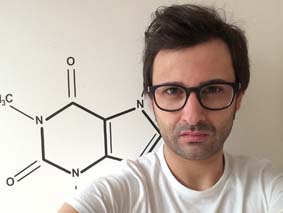
A research where the researcher of the Universitat de València Josep Rubert participated, together with scientist of the University of Chemistry and Technology of Prague (Czech Republic) proved that most of the saffron labelled and exported as Spanish comes from other countries. The team proved, through the chemical digital fingerprint of each type of saffron, that more than the 50% of the samples were fraudulent. The work was based on the analysis of 44 commercial products.
Josep Rubert, researcher of the Universitat de València, explains that for some years now the media has been reporting this fraud, but until now were barely no analytic tools to detect it. For this reason a new authentication strategy of saffron based on the metabolomics has been developed; that is to say, the chemical digital fingerprint of food.
According to the publication of the SINC news agency of the Ministry of Economy and Competitiveness, the red stigma of the saffron flower (Crocus sativus) is one of the most old and expensive species of the world, specially those varieties internationally recognised for their quality, such as the saffron cultivated in Spain. This favoured the fraudulent activity of labelling as Spanish a saffron that it is not.
This new technic makes it possible to differentiate three types of saffron: the one certified with the Protected Designation of Origin symbol (DOP) of La Mancha or Aragón, the saffron cultivated and packed in Spain (without the DOP) and the one labelled as Spanish saffron that, despite its name, is from an unknown origin (although it is likely to be packed in our country).
With these possibilities, Rubert, together with scientist od the University of Chemistry and Technology in Prague (Czech Republic), where he is also a Postdoctoral Researcher and where he carried out this research, collected 44 saffron commercial samples to check the veracity of their labels.
The results, published this month in the Food Chemistry journal, reveal that more than the 50% of the samples were fraudulent, since 26 samples labelled as Spanish saffron were not cultivated nor processed in Spain. According to the research, it is highly probable that this saffron is bought at a lower price in other countries (such as Morocco, Iran or India, according to our data), points out the researcher, and it is after packed and sold as Spanish. A fraud that gables with the trust of consumers.
The developed technic by these Czech and Spanish scientists confirmed that the saffron labelled with the DOP symbol of La Mancha (and Aragón) were cultivated and processed in Spain. According to Rubert, there was no fraud, these samples matched perfectly with our models; but this was not the case of the Spanish saffron samples, which had a metabolome or a completely different set of small molecules.
Chemistry and statistics
In order to develop its methodology, the authors united chemistry and statistics. The first phase of the research consisted in identifying the saffron characteristic metabolisms or small molecules. After that, they created a method to detect them through the liquid chromatography high resolution tandem mass spectrometry.
On the other hand, the statistic treatments were useful to detect the clear differences between the three types of saffron and to validate the technique. According to the authors, the result is an excellent quality model that classified correctly the 100% of these samples and, presents a prediction capacity higher to the 85% for other samples (even they are unlabelled and unknown).
Regarding the best molecular markers to identify the origin of saffron, the authors suggest that are the glycerophospholipids and its oxidized lipids. They also observed that the saffron technology or processing has a key role, concretely during the drying where transformation products are formed according to the temperature of the process and linked to the origin.
If in Spain an annual average of 2.813 kg of saffron is produced and 35.978 kg are exported, where do the other 33.165 kg of difference come from? For example, the La Mancha saffron is dried spreading the fresh stigmas out on sieves, that are placed next to heat sources such as fire, embers, cooks or braziers. The dehydration is quick, it takes around half and hour, and it is carried out at a temperature of 70ºC, which accelerates the oxidation of the lipids.
Huge gap between production and exportation
During the last decades the Castilla-La Mancha saffron was more than the 97% of the national production, presenting a huge gap concerning the exportations of this product. Between the years 1997 and 2013 was produced an average of 2.813 kg of saffron per year in Spain, however an annual average of 35.978 kg was exported. Where did the other 33.165 kg come from?
They come from other countries such as Iran or Morocco, says Pedro M. Pérez, manager of the Regulating Council of the Denomination of Origin of La Mancha, and keeps saying that that foreign saffron is brought here and labelled as “made and packed in Spain”, which is true but its real origin is not specified. For this reason the consumer does not have the enough information to value it.
The manager remembers that exists a national regulation since 1999 and a European one from 2011 on the proper labelling of food products, but the competent bodies of the autonomic communities are not fulfilling their task concerning the saffron case.
Article:
Josep Rubert, Ondrej Lacina, Milena Zachariasova, Jana Hajslova. Saffron authentication based on liquid chromatography high resolution tandem mass spectrometry and multivariate data analysis. Food Chemistry, January 2016 (on line). Doi:10.1016/j.foodchem.2016.01.003. (Research carried out at the University of Chemistry and Technology (Prague, Czech Republic), within the project VALr+d in postdoctoral phase APOSTD/2014/120 by the Education, Culture and Sport department of the Valencian Government).
Last update: 19 de january de 2016 14:00.
News release



















